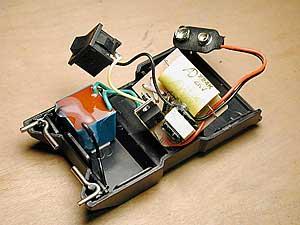Table of Contents
- Identifying Common Causes of a Frozen or Locked-Up Stun Gun
- Safety Precautions Before Attempting Any Repairs
- Step-by-Step Troubleshooting Techniques to Restore Functionality
- Maintenance Tips to Prevent Future Freezing or Lock-Ups
- Insights and Conclusions
Identifying Common Causes of a Frozen or Locked-Up Stun Gun
Understanding why your stun gun has become frozen or locked-up is the first step toward restoring its functionality. Often, internal battery issues are a primary culprit; a depleted or damaged battery can cause the device to halt operations or fail to respond at all. Additionally, excessive moisture or exposure to extreme temperatures can disrupt the stun gun’s internal circuitry, leading to unresponsiveness. Dirt and debris accumulation inside the casing is another frequent cause, as it can interfere with the electrical contacts and safety mechanisms.
Mechanical failures such as a stuck activation switch or a faulty safety lock can also prevent your stun gun from engaging properly. Sometimes, problems arise from improper charging habits or using incompatible chargers, which can overload or undercharge the battery. To quickly identify the issue, inspect for signs of physical damage, verify the charging source, and check if the stun gun’s safety features are unintentionally enabled. Keeping an eye on these common pitfalls can significantly reduce frustration and downtime.
- Battery depletion or corrosion
- Exposure to moisture or temperature extremes
- Dirt or debris inside the device
- Faulty activation or safety switches
- Improper charging or charger issues
Safety Precautions Before Attempting Any Repairs
Before diving into any repairs on your stun gun, your safety must be the top priority. Always disconnect the device from any power source and remove batteries if possible. This simple step prevents accidental discharge, which could cause serious injury. Furthermore, wear protective gloves and safety glasses to shield yourself from unexpected sparks or debris that might fly off during the repair process. Never attempt repairs in a wet or damp environment as moisture can cause electrical shocks or worsen the device’s condition.
Take a moment to prepare your workspace carefully. Choose a clean, well-lit area with plenty of room to organize tools and parts. Avoid clutter to reduce the risk of losing small components or accidentally knocking the stun gun over. It’s also advisable to have a fire extinguisher nearby, just in case. Keeping a basic first-aid kit close ensures you are ready for minor injuries. Remember, understanding the stun gun’s manual and technical specifications before attempting any fix is essential, so you avoid causing further damage or voiding warranties.
Step-by-Step Troubleshooting Techniques to Restore Functionality
Begin by disconnecting the stun gun from any power source and removing any batteries if applicable. This step is crucial to ensure your safety and prevent accidental discharge. Next, give the device a gentle shake to dislodge any debris or loose internal components that might be causing the freeze. Avoid pressing any buttons repeatedly as this can drain the battery or worsen the issue. Once disconnected and inspected externally, let the stun gun rest for at least 10 minutes to allow any residual electrical charge to dissipate.
After the waiting period, reinsert the batteries-ideally fresh and fully charged ones-and perform a visual check for corrosion or contacts obstruction. Use a soft cloth slightly dampened with isopropyl alcohol to clean the battery contacts and circuit board (if accessible). Now, try powering on the device. If it remains unresponsive, reset the stun gun by holding down the main activation button for 15-20 seconds; this can often recalibrate the internal circuit. If your model has a fuse, inspect and replace it as necessary. These troubleshooting steps, when followed carefully, can often restore your stun gun’s full functionality without professional repair.
Maintenance Tips to Prevent Future Freezing or Lock-Ups
Ensuring your stun gun operates smoothly over time requires consistent attention and care. Start by storing the device in a dry, temperature-controlled environment to prevent moisture buildup, which can contribute to internal freezing or lock-ups. Regularly inspect the battery for signs of corrosion or wear and replace it if necessary. Using the recommended battery type will also enhance performance and reduce the likelihood of power-related malfunctions. Additionally, avoid exposing your stun gun to extreme temperatures-both hot and cold-as these conditions can degrade internal components and lead to freezing issues.
Incorporating a simple maintenance routine can significantly extend the lifespan of your device and keep it ready for use. Consider these key practices:
- Clean the contacts gently with a soft cloth to prevent dust and debris accumulation.
- Test the functionality monthly to identify potential glitches early.
- Lubricate mechanical parts if recommended by the manufacturer to avoid stiffness.
- Keep firmware updated when applicable, ensuring optimal system performance.
Insights and Conclusions
In conclusion, dealing with a frozen or locked-up stun gun can be frustrating, but with the right approach and careful steps, you can often get it back in working order quickly and safely. Always remember to handle your device with care, follow manufacturer guidelines, and prioritize safety throughout the troubleshooting process. If your stun gun continues to malfunction despite your efforts, consulting a professional or considering a replacement may be the best course of action. Stay prepared and informed to ensure your stun gun remains a reliable tool for your personal safety. Thanks for reading, and stay safe out there!Check Our Other Blogs
- StunGun – Your Trusted Source for Stun Guns, Laws, and Self-Defense Tips
- PepperSprayLaws – Your Trusted Resource for Pepper Spray Information
- StunGunLaws – Your Trusted Guide to Stun Gun Legality and Safety





